TECHNICAL INFORMATION
Provides technical information related to products by AQUOSYS.
HOME
TECHNICAL INFORMATION
DAF
HELIFLOT™: Innovation of Dissolved Air Flotation
- 1. Overview of the general Dissolved Air Flotation (DAF):
- DAF is a water treatment technology that purifies water by removing suspended matter through the use of fine bubbles from dissolved air.
Advantages and disadvantages of DAF compare to Sedimentation
| Advantages | Disadvantages |
|---|---|
|
• High speed treatment • Produces thick sludge • Shorter flocculation detention time • Shorter start-up lead time • Compact facilities required • Omissible for recovered sludge thickener |
• Requires more complex facilities • Consumes more electrical power • Unsuitable for highly silt-laden water |
- 2. Introduction of HELIFLOT™
- HELIFLOT™ is a cylindrical DAF unit that runs with helical flows, developed by Aquosys.
- Raw water and fine bubbles are fed into the flotation tank (①) by an inflow pipe connected to the tangent (②).
- Suspended materials form flocs with fine bubbles, creating a helical flow with the water to move upwards (⑥) and gather around the center of the water surface (⑧). The flocs are discharged out of the flotation tank through a scum outflow pipe (④).
- The treated water then creates another helical flow to move downward (⑦) inside of the helical flow moving upwards.
They are then discharged continuously out of a treated water outflow pipe (③). - The water level of the flotation tank is controlled with a flow control valve (⑨) suitable for scum control.
- Silt or something dense moves to an outer position on the flotation tank by centrifugal force. It settles down to the conical bottom and then evacuates to the outside periodically (⑤).
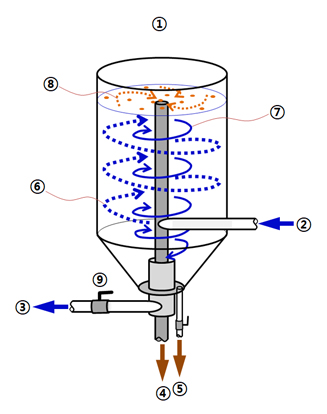
- 3. A suspended material removal process by the HELIFLOT™
- Simple and high efficiency
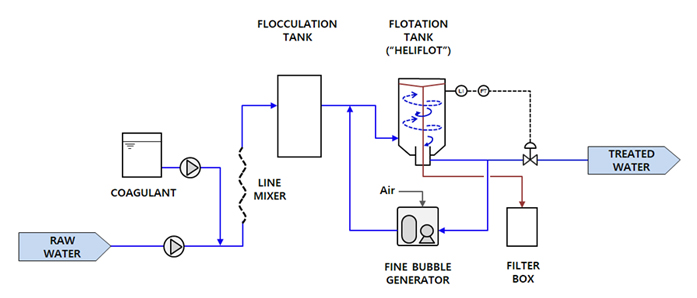
- 4. Applicable wide range of contaminated water treatment
- From very low concentrations of algae water to high concentrations of settled sludge:
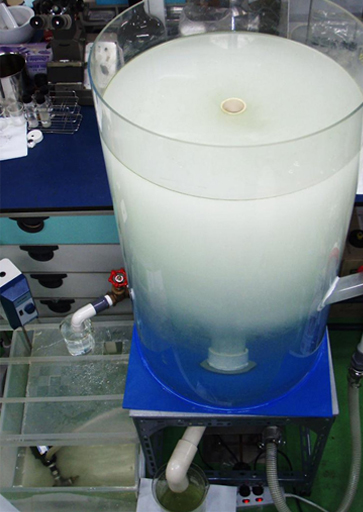
Algae Water Treatment

Sludge Concentration
- 5. Comparison with HELIFLOT™ to the conventional DAF
| Conventional DAF | HELIFLOT™ |
|---|---|
|
• More complex facilities required: – Scum skimmer, subnatant remover and (settling lamella plates) needed. • Weak on load fluctuation • Unsuitable for treating high silt-laden water. • Compact facilities required: – Detention time(min): Floating: 20 ~ 30 Conglomeration: 15 ~ 20 • Chemical consumption(ppm): – Organics: 5 ~ 10 – Inorganics: 10 ~ 30 (normally both chemical required) • Electric consumption(kWh/㎥): – 0.08 ~0.12 (Depends on the capacity) |
• Simplified facilities: – No scum skimmer, subnatant remover or settling lamella plates needed. • Stable on wide range of load fluctuation (even low flow rate or high solid content) • Capable for treating high silt-laden water. • More compact facilities required – Detention time(min): Floating : 8 ~ 10 Conglomeration : 0 ~ 15 • Chemical consumption(ppm): – Organics: 0.5 ~ 2 – Inorganics: 2 ~ 10 (available only one chemical used) • Electric consumption(kWh/㎥): – 0.06 ~0.10 (Depends on the capacity) |
- 6. Applications of HELIFLOT™:
- Tap water clarification (for pre-treatment or replacement of a flocculation and sedimentation process).
- Sewage and wastewater treatment (for pre-treatment or sludge thickening).
- Seawater desalination (for clarification).
- Industrial processes (for recovery of valuable effluences).
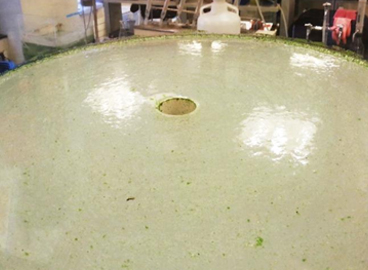
Scum on HELIFLOT
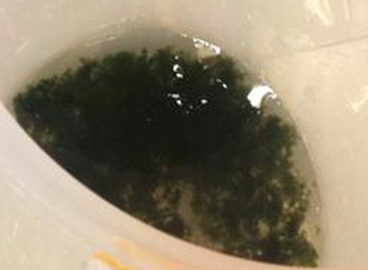
Removed scum
- 7. Standard Specifications
| HLF 100 | HLF 1000 | HLF 5000 | HLF 10000 | HLF 20000 | |
|---|---|---|---|---|---|
| Treatment rate (㎥/day) | 100 | 1000 | 5000 | 10000 | 20000 |
| Flotation tank volume (㎥) | 0.8 | 8 | 40 | 80 | 160 |
| Ground required (㎡) | 8 | 16 | 52 | 84 | 112 |
| Height (m) | 2.8 | 3.4 | 4.6 | 5.8 | 7.0 |
* Depending on the suspended solids in the water, the conglomeration tank may be required or omitted.
- 8. Examples of the HELIFLOT™:
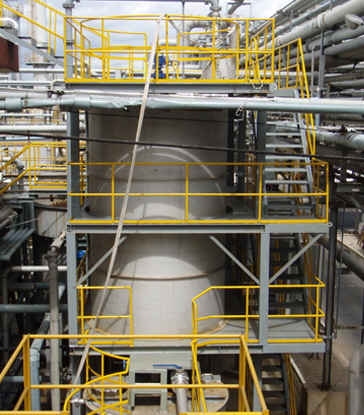
2,400㎥ /day

16,000㎥ /day